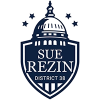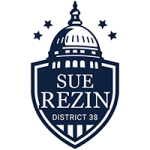U.S. Representative Rodney Davis provided the following federal legislative update regarding COVID-19.
PHASE I
HR 6074, the Coronavirus Preparedness and Response Supplemental Appropriations Act – President Trump signed into law March 6
Provides $8.3 billion in emergency funding for federal agencies to respond to the coronavirus outbreak
$4 billion to develop testing, therapies, and vaccines
$1 billion State set-aside for surveillance, testing, and containment
$500 million to purchase Personal Protective Equipment (PPE)
$100 million for Community Health Centers to purchase PPE, test and treat coronavirus patients, and expand telehealth capabilities
Authorizes the Small Business Administration (SBA) to provide Economic Injury Disaster Loans
Maximum of $2 million/business to be repaid over a maximum of 30 years at 3.75% interest – you have cosigned a letter to SBA requesting this interest rate be 0%
PHASE II
HR 6201, the Families First Coronavirus Response Act – President Trump signed into law March 18
Ensures the Federal government is partnering with the private sector to achieve free medical diagnostic testing for COVID-19
Provides states with a 6.2% Medicaid FMAP increase to help states shore up Medicaid financing
Provides Paid Sick Leave and Expands FMLA protections, both backed by a payroll tax credit
These provisions are effective starting April 1, 2020, and apply to leave taken between April 1, 2020, and December 31, 2020
Employers with 500 or less employees must offer up to 2 weeks paid leave
Ill or quarantined employees receive 100% pay rate ($511/day cap), those taking care of others receive 66% pay rate ($200/day cap)
Employers with 500 or less employees must grant FMLA leave for an additional 10 weeks to employees at home caring for a child – at 66% pay rate ($200/day cap)
The Department of Labor (DOL) has waiver authority for employers with fewer than 50 employees
DOL has issued guidance instructing employers to document details and facts that form basis for waiver – there is no formal process
Must show leave would cause employer to cease operating (whether due to financial strain or employee’s skill set) or that the employer cannot find a workforce necessary to operate at a minimal capacity
Provides $1 billion in emergency assistance to states to bolster unemployment insurance
Provides $500 million to States for staffing, tech, and administrative purposes, and $500 million in emergency grants for states who see a 10% increase or more in Unemployment
Nutrition Provisions
Provides $500 million for WIC, $400 million for TEFAP and $250 million for the Senior Nutrition Program
Ensures students home from school can still receive free/reduced meals
PHASE III
H.R. 748, the Coronavirus Aid, Relief, and Economic Security Act – President Trump signed into law March 27
SBA Payment Protection Loans
Provides $350 billion to create a new Payment Protection Loan program which provides loans to small businesses and 501(c)(3)’s with less than 500 employees, sole proprietors, independent contractors, and self- employed individuals
These loans are 100% backed by the federal government with an interest rate of 1%
Loan amounts will be based on 2.5 times the average monthly payroll of the business or $10 million, whichever is less
Lenders are given delegation authority meaning these loans can be in the hands of small businesses without time consuming SBA authorization
The program provides for automatic deferral of principal, interest, and fee payments for the first six months
Amounts used to cover payroll costs, mortgage interest payments, rent, and utility bills over an 8-week period will be forgiven if the business retains employees
Forgiveness is reserved for employers that maintain payroll continuity from February 15, 2020 through June 30, 2020
Flexibility is granted for businesses to rehire individuals already laid off and still be eligible
Failure to maintain payroll continuity does not immediately disqualify forgiveness, instead, if employee numbers decrease the forgiven amount is reduced proportionally based on the prior year’s headcount
Businesses will work with lenders to establish that it met payroll requirements, at which time the federal government will purchase the loan
For franchisees in the hospitality and food industries, the loan is available at the store/location level – allowing more small businesses to qualify
Individuals who have received an SBA Economic Injury Disaster loan may refinance into this new program
Unemployment Insurance
Creates the Pandemic Unemployment Assistance (PUA) program to provide federal unemployment coverage for individuals traditionally not eligible for unemployment assistance
Includes self-employed and independent contractors
Available through December 31, 2020 to individuals unable to work due to the Coronavirus
Calculated based on each state’s average unemployment
Funding provided for states to administer
Pays states to cover 50% of the costs incurred through December 31st, 2020 for expenses related to providing unemployment benefits to government, nonprofit, and tribal workers
Provides an additional $600/week to individuals receiving traditional unemployment benefits or payments under the PUA program – through July 31, 2020
Individuals who have exhausted state unemployment benefits, are eligible for an additional 13 weeks of benefits through the PUA program
Economic Stimulus
Up to $1,200 in economic recovery checks to individuals ($2,400 for joint filers) with an additional $500/dependent under 17
Income eligibility based on 2019 returns if filed, or 2018 if unfiled:
Individuals with AGI below $75,000 are eligible for $1,200
Joint Returners with AGI below $150,000 are eligible for $2,400
Phases out above these thresholds until eliminated at $99,000 for individuals and $198,000 for joint returners
Waives the 10% early withdrawal penalty for distributions from qualified retirement accounts (up to $100,000) to cover coronavirus- related expenses
Waives the required minimum distribution rule for 2020
Permits a 2020 $300 above-the-line deduction for charitable donations
Incentivizes businesses to pay down student-debt by providing a tax-free benefit (up to $5,250) for both the employer and employee
Provides a refundable payroll tax credit for businesses equal to 50% of wages (up to $10,000/employee) paid during the COVID-19 crisis
Ineligible for credit if receiving assistance through SBA
Healthcare
$100 billion for hospitals to keep their doors open to cover cancelled elective operations and declining visits unrelated to coronavirus
$1.32 billion for community health centers
Expands Health Savings Accounts (HSA) to cover telehealth services related to COVID-19, and HSA and Flexible Spending Accounts to purchase over-the-counter products
Allows Medicare reimbursement for telehealth services provided by Federally Qualified Health Centers and Rural Health Clinics during the COVID-19 response period and allows for reimbursement when seen by a new doctor
Increases Medicare reimbursement for COVID-19 patients by 20%
Extends Community Health Center funding through November 20, 2020
Education
Defers federal student loan payments for 6 months (through September 30, 2020)
Provides $30.9 billion to create an Education Stabilization Fund to assist elementary, secondary, and higher education institutions
Economic Stabilization Fund
Provides $500 billion to the Treasury Department to assist severely distressed industries through loans
Includes a $25 billion set-aside for passenger air carriers, $4 billion set-aside for cargo air carriers, $17 billion for businesses vital to national security, and $454 billion for other industries
Loans under this program are reserved for businesses unable to receive lending through other means and limited to a 5-year maximum life. Additionally, businesses accepting loans must retain at least 90% of their workforce (as of March 24, 2020) through September 30, 2020 and must be a U.S. domiciled business
Businesses that accept assistance are prohibited from buying back stock and increasing the compensation of employees making more than $425,000
Prohibits businesses from receiving assistance if anyone owning a 20% interest in the business is the President, VP, head of an executive branch department, Member of Congress, or any such individual’s spouse, children, or son/daughter-in-law
Provides $25 billion in grants to passenger air carriers, $4 billion for cargo air carriers, and $3 billion for airline contractors, to cover employee wages, salaries, and benefits
Prohibits stock buy backs through September 30, 2020, and freezes compensation for employees earning over $425,000 for two years
Provides the Secretary of Treasury the ability to collect stocks and other such financial instruments in lieu of payment for the grants
Coronavirus Relief Fund
Provides $150 billion for State and Local governments through direct payments to cover expenses related to COVID-19.
Amounts/State based on the state’s relative population but no less than $1.25 billion – Illinois should receive around $5 billion
Federal Assistance to Illinois
Illinois has either received, or will receive shortly, the following list of PPEs and ventilators from the Centers for Disease Control (CDC) Strategic national Stockpile:
Topline Total – 3,438,218 pieces
N95s – 540,523
Surgical Masks – 1,285,657
Face Shield – 260,330
Surgical Gowns – 213,230
Coveralls – 7,621
Gloves – 1,130,407
Ventilators – 450
Chicago’s Share – 1,180,414 pieces
N95s – 172,763
Surgical Masks – 410,569
Face Shield – 85,939
Surgical Gowns – 70,556
Coveralls – 3,626
Gloves – 436,811
Ventilators – 150
Rest of Illinois’ Share – 2,257,804 pieces
N95s – 367,760
Surgical Masks – 875,088
Face Shield – 174,391
Surgical Gowns – 142,674
Coveralls – 3,995
Gloves – 693,596
Ventilators – 300
The Department of Health and Human Services (HHS) has provided nearly $3.7 million to Community Health Centers (Phase I)
HHS has provided nearly $35.8 million to the State through the Centers for Disease Control to contain the spread of COVID-19 (Phase I and before that through transfers of funds within the Department).
FEMA has provided $1,374,160.69 to IEMA for state management costs associated with COVID-19 (Disaster Declaration).
The Department of Housing and Urban Development provided $80.5 million through Community Development Block Grants (Phase III)
The Department of Transportation provided $1.623 billion for transit districts (Phase III).

